Environmental Water (also known as E-Water or E-Flows) are releases of water from the large impoundments that flow down the rivers or is diverted to specific areas within a catchment (like billabongs, or flood runners) to benefit the ecosystem. These e-flows are targeted to preserve the health of wetlands and billabongs, and often the river channels themselves.
E-flows are intended to, help native fish, birds and frogs, and also support vegetation like red gum forests that have been impacted by river regulation – essentially they aim to preserve or restore life to the ecosystem.
‘E-flows usually try to mimic what happened naturally via flooding and variable river flows before river regulation.’
Historically, parts of the floodplain would usually be covered by a flood every couple of years which would help rejuvenate the entire system and flush accumulated carbon from the floodplain into the rivers. In regular small doses (i.e. regular flooding) this carbon is what fuels the river ecosystem – it drives the bottom of the food web, which supports everything, right up to fish.
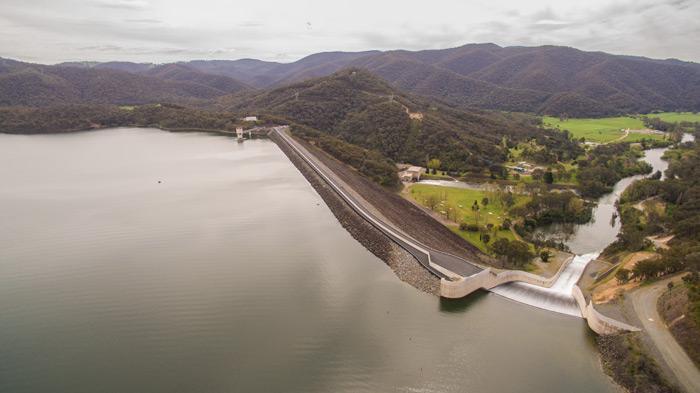
Blowering Dam is a large water storage in the Murrumbidgee River catchment. Credit: photo by Grant Higginson
How e-flows affect Fish
Reproduction
In the last few years environmental flows are used more and more to help native fish populations to breed and grow. In terms of reproduction for golden perch it’s crucial that they have floods or high flow pulses that remain within the river channels during spring-summer to spawn. Females generally won’t lay eggs if the conditions aren’t perfect, unlike cod who will usually lay their eggs in a ‘nest’ around the same time each year (spring) in response to water temperature rises and longer days.
Golden perch will produce their eggs in preparation for the appropriate temperature and flow conditions and if this doesn’t eventuate they absorb the eggs back into their system, converting it into energy rather than investing this energy into young fish that may not survive for long.
This means that during the period of drought like we not long came out of some fish may have gone over 10 years and not laid a single egg. This is damaging for the species in the longer term as they need successful reproduction somewhere in a river system every year, and big breeding events like that which happened after the last floods. This needs to happen every couple of years to really give the population a boost.
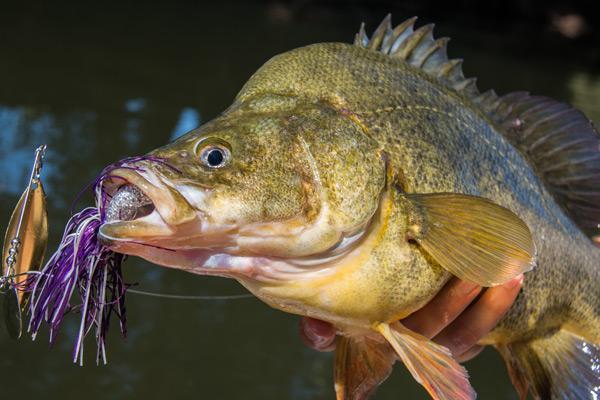
Large Golden perch like this need the perfect flow, water temperature and conditions to spawn. This is where e-flows can be used to mimic a flood to help the perch breed.
Case Study: Travelling Golden Perch
Words and information by Iain Ellis – Fisheries
“Most people don’t really know that in 2008-09 during the Millennium drought a flow pulse down the Darling River prompted Golden perch to spawn, and the eggs and larvae drifted downstream into the Menindee Lakes where it appears they grew quickly in the warm, food-rich lakes habitat. Scientists refer to these sorts of places as “nursery habitat”. When a larger flood hit the Darling the following year, millions of these juvenile perch were transported into the Murray system with the floods. Clever scientists from SARDI in South Australia looked at the chemical make-up of the ear-bones (called otoliths) of Golden perch throughout the Murray River system and found that to this day, a really large proportion of the perch we catch from the Lower Lakes in SA up through mid-Murray and Edward-Wakool River systems, originated in the Darling River in that 2008-09 flow pulse. That one spawning event contributed to the strongest cohort of perch throughout thousands of river kilometres.
Environmental water should be used not just to cue native fish to spawn, but also to provide the right flows enabling them to survive and move around.
For example, maintaining a constant low flow in winter (rather than letting streams stop flowing and dwindle to a series of pools just because irrigation and domestic water demand is low), will enable that stream to support a greater number of fish over-winter when resources or water quality in a pool might deteriorate. This means more fish will be in the stream ready to gear up for breeding come spring when flows generally increase in the Murray and Murrumbidgee.”
Food and Survival
For fish it’s not just about spawning. Floods and elevated river flows also bring food which is vital for native fish growth and survival. When the fish hatch from the eggs they will need to begin feeding within a few days. This is why native fish generally time their breeding to happen in time with higher flows and floods, when high amounts of plankton and microorganisms are likely to be in the water and greater areas of inundation provides protection in the form of flooded structure, billabongs and wet lands. If the eggs and tiny larvae that are spawned don’t have the right flow conditions to transport them to nursery habitat, or generate food for them, they won’t survive to larger sizes. Scientists call this survival ‘recruitment”, which means there are young fish coming in to a population to replace older fish which die. Without regular recruitment we can expect numbers to decline.
Juvenile fish can often live the first part of their life in these areas – in the example above the Menindee Lakes can provide really good nursery habitat for Golden perch when they flood. Maturing fish later make their way back to the main river or creek, but this can only happen with follow-up floods to connect these nursery areas back to the rivers before they dry out.
So E-flows can play an important role in providing food for young fish, and in transporting them to and from productive nursery habitats. E-flows can also help ensure regular transport of young fish from breeding grounds downstream to repopulate lower areas in the river system.
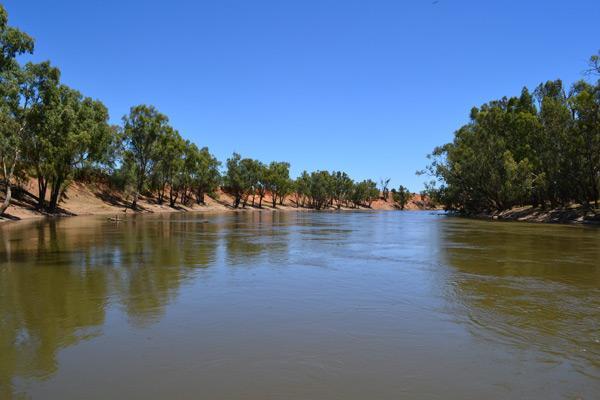
High flows help distribute food for juvenile fish and aid in safe travel. This is the Murrumbidgee River in high summer flows.
Travelling Upstream
Floods and high river flows also help maturing fish to travel back upstream and that’s extremely important in repopulating higher areas with young fish. As they grow many fish instinctively travel back upstream (this is really evident in Golden Perch and Silver perch) which counters the downstream travel experienced as drifting eggs and larvae. They can travel thousands of kilometres over their lifetime which enables them to repopulate damaged areas of the waterway.
But this can only happen in higher flows and floods, which provide connectivity between and the flow velocities which cues them to move – essentially the confidence to travel without becoming stranded. With high flows there are more pathways in which the fish can travel and therefore less chance of being found by a larger predator.
As you will have noticed I have been talking about how floods and high flows benefit fish in many ways (spawning, food, survival and movement). E-flow can be just like floods and to native fish so long as the e-flows are appropriately planned.
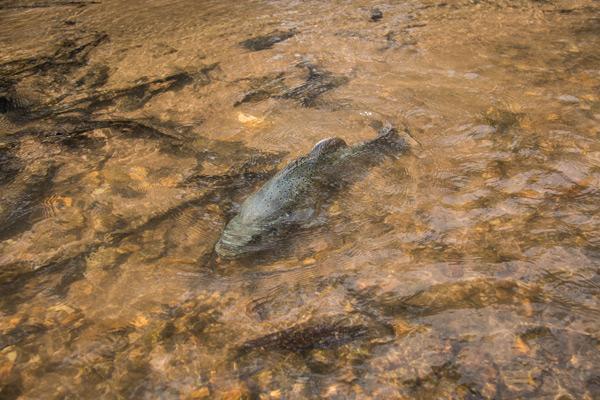
Fish passage and travelling is important to help repopulation to different areas. When the water is low this can be difficult for fish as they are open to predation.
To learn more about how flows can help native fish see:
www.dpi.nsw.gov.au/fishing/habitat/publications/pubs/fish-and-flows-in-the-murray-river-catchment
The Way of Modern Life
Water is the most important resource for human life and a need for more secure supply of water resulted in the construction of weirs, dams, locks and channels (River Regulation) to hold back and control water in rivers. This was necessary for the development of towns and agriculture for survival in a semi-arid landscape.
‘In the process of regulating river systems, we have inadvertently disrupted the natural flow of rivers and in many cases flipped the ecosystem upside-down.’
Instead of receiving frequent floods, we hold much of this water back until it’s needed and leave little for the river ecosystem. Native fish in the Murray-Darling Basin have adapted to diversity and variability in flowing water conditions over many thousands of years. We’ve managed to alter the flow patterns in most rivers, and the way they connect with their floodplains, in just a handful of generations – the last 100 years or so. As a result, native fish populations in the MDB remain in a poor state – poorer than most people or their parents or grandparents would even recognise. Around half of the nearly 50 native species we know of in the Murray-Darling Basin are currently listed as threatened at some level.
This is the very reason why environmental watering should help mimic small floods and natural flow variability in rivers as much as possible. Unfortunately we have altered the rivers and floodplains so much that it’s impossible to mimic larger flooding exactly because they would inundate much of the flood plain which is now used for agricultural or community benefit.
Consequently the e-flows instigated to date are much smaller than the floods that used to happen, but in many cases they have still help boost fish reproduction.
Case Study: E-flows to Boost Fish Productivity in the Darling River
Words and information by Iain Ellis – Fisheries
“A recent example is environmental flows in spring 2016 to increase breeding habitat for Murray cod in the Darling River below the Menindee Lakes. The cod responded by investing heavily in spawning and huge numbers of larvae were detected by researchers throughout October and November. Ongoing delivery of e-flows should help a good proportion of these young to survive to adult-hood….something much needed given the recent impacts of blackwater in the nearby Murray River. Plans are being made to help juvenile Golden perch (which were spawned up in the Darling River during recent floods and washed down to the Menindee Lakes nursery habitats), return to the Darling and Murray Rivers, mimicking example from 2008-2010 described above. So long as it doesn’t impact on water security for the folks in the lower Darling region, this can only be a good thing for fish stocks throughout the southern Murray Darling Basin.”
E-flows to Help Blackwater Events
Another purpose of e-flows is to help minimise the impact the hypoxic Blackwater events that are becoming ever more prevalent in recent years. This is due to the large amounts of organic matter that is being picked up by large floods. This organic matter would have historically been flushed into the rivers every couple of years due to large flooding. Today, as a result of river regulation, it now accumulates for decades on dry floodplains and causes devastating affects when finally washed back into the river.
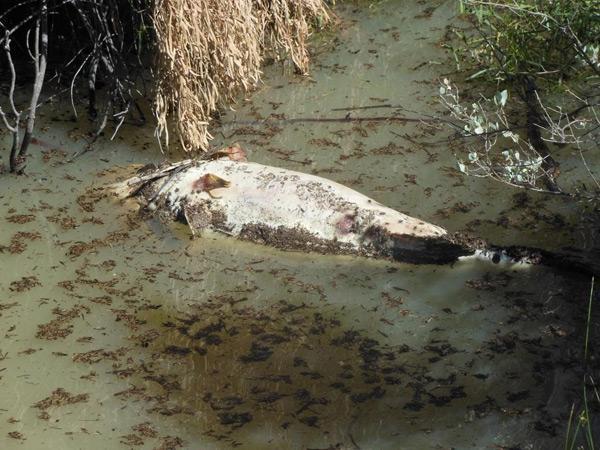
E-flows can be used to help flush low lying areas to prevent fish kills. This fish perished in the Rufus River due to Blackwater during the 2016 floods. Credit: photo by Andy Wise.
E-flows can be designed to flush low lying areas of floodplains frequently to help reduce the impact of Blackwater events in larger floods. The flush of water would pick up the small amount of organic matter from the floodplain and wash it back into the river. The longer the period without a flood, the more organic matter builds up, and the more hypoxic a blackwater event would be expected when a flood occurs. This is the reason the flood plains need regular flushing to help reduce the possibility or at least the severity of major Blackwater events in times of large floods.
Want to learn more about Blackwater… click here
Case Study: E-flows on the Yanga Floodplain – Murrumbidgee River
Words and information by Iain Ellis – Fisheries
“Recent science indicates that regular e-flow flushing of the lower lying parts of the Yanga Floodplain (in the lower Murrumbidgee River) meant the impacts of the recent natural flood in terms of decomposing carbon load was reduced, and as a result fish kills were far smaller in magnitude than expected. This is despite the 2016 floods inundating 5-10 times the area which environmental flows can target without causing damage to farm land.”
E-flows from an Anglers Perspective
As an angler being someone who is on the waterways every weekend we first-hand experience the ups and downs of the river. Taking note of what turns fish on and off the bite is something that comes natural to a keyed in angler and environmental conditions are one of the biggest factors that affect fish behaviour.
When fishing along our rivers we have most success on a steady and low flowing river. Reasons behind this are because low water exposes more structure to anglers and more importantly it reduces the current flow and speed. This allows us to get our lures down into the strike zone and also safely navigate our boats up and down the river. This in turn leads to increased catch rates of fish.
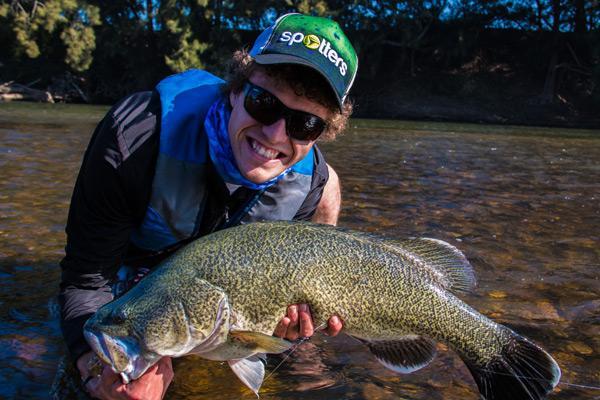
The author with a beautiful Murray Cod taken on a low and steady flowing Murrumbidgee River - these are the perfect fishing conditions for anglers.
Another point we have found with our experience is when the water flow is steady the water temperature is steady and therefore we catch more fish. By catching more fish we assume that they are in a comfortable and happy environment because they are happily feeding. When we see a change in water level (either up or down) we notice a drop in fish activity. One because the temperature will either drop or rise and this upsets the fish and also because the fish either have to retreat down to different structure or push up onto newly submerged structure. Another point to note is fish may also be travelling during higher flows or pulses of water. Especially when it comes to Golden perch, so possibly they are migrating rather than sitting on structure feeding.
‘From this, as an angler we would prefer to go fishing on a steady flowing river, whilst scientific research and information received from fisheries suggests it’s better to have variability in the water level and flow to promote fish numbers.’
Furthermore, anglers experience what happens on the river first hand and have a good feel for how fish may be reacting to flow management. We collectively hold a wealth of knowledge that could, and should, be of benefit in decision making when it comes to environmental flows. It’s crucial that we are included in river management discussions, and hopefully the trend in increasing angler engagement by governments will continue to maximise the potential we hold.
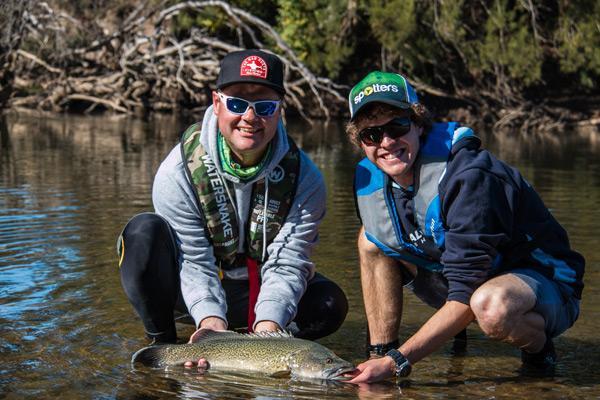
What say do anglers get in water management? Will there be a chance for us to fish a low and safe flowing river?
The other point to note is if the water is to fluctuate year round how much time can we get out on the water and successfully catch fish in a safe environment? As mentioned elsewhere on this site, the potential for an online calendar or an app that shows planned releases and river heights would enable us to plan fishing trips in advance knowing that you won’t get washed out by a rising river.
E-flows for the Environment
The E-flows are not just for fish, it also includes benefits for trees and other native vegetation, birds, billabongs, wetlands and lagoon ecosystems. In terms of management, there are a number of bodies and organisations that have an input on how water releases are managed. If you want to learn more about which organisations manage water and e-flows in your region, visit the MDBA website (www.mdba.gov.au) or website of your state water authority.
Environmental flows are in place to help boost productivity for the environment which includes native fish. From a fish point of view its aim is to inundate the flood plain to clean up the organic matter, help bring life to low lying areas and provide a flood like situation to help native fish populations.
Rhys Creed
If you want to read more stories and information about how e-flows and river management can help native fish, visit:

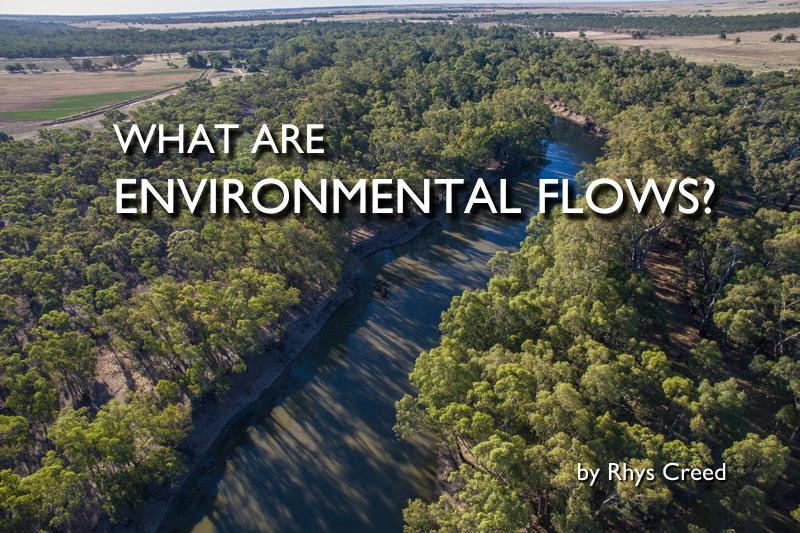
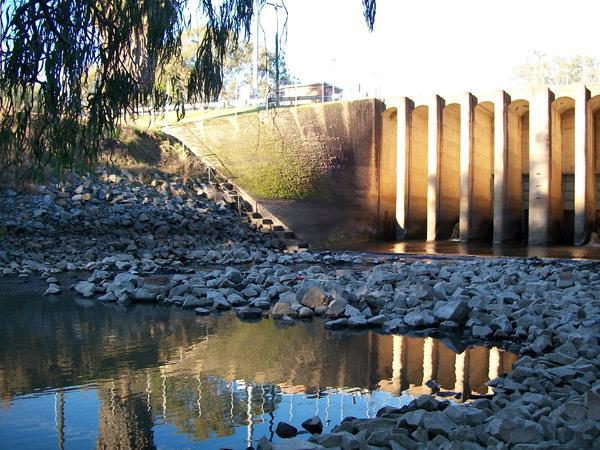
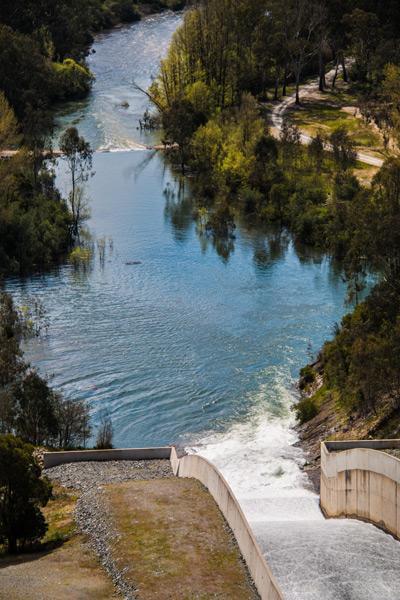
0 comments